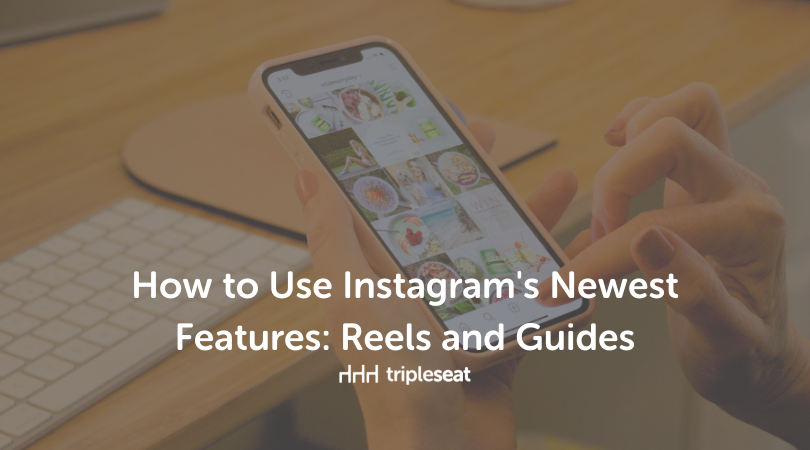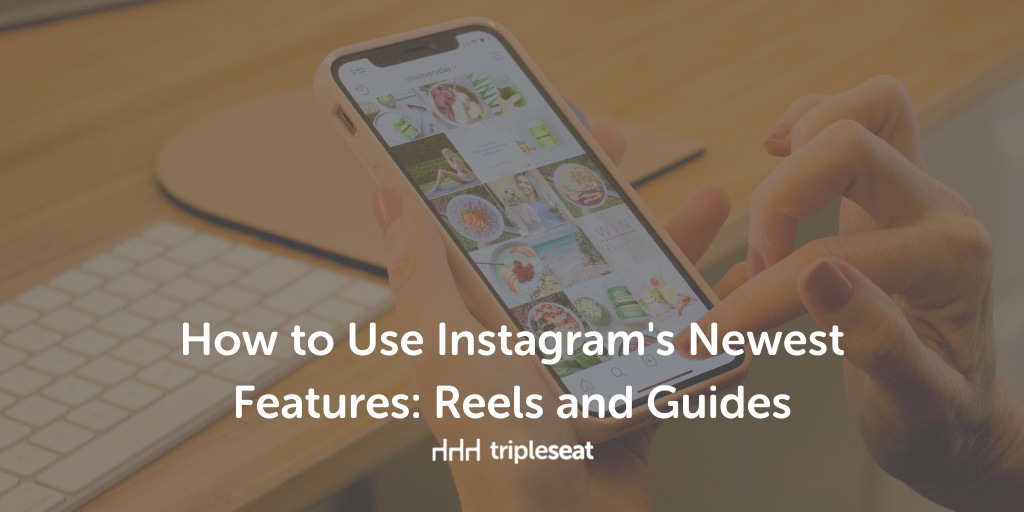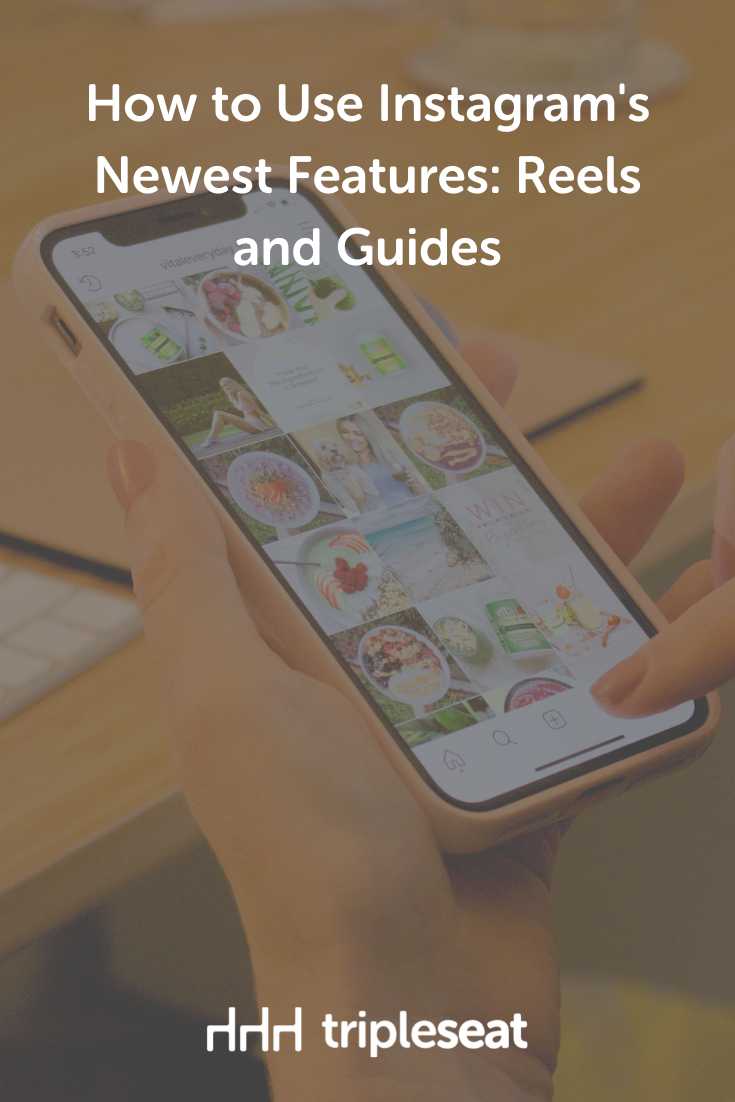How to Use Instagram’s Newest Features: Reels and Guides

The world of social media marketing is constantly changing in order to engage new audiences in creative ways. That means that the social media platforms we know and love also have to change to keep up with new ways of marketing.
The powerhouse platform of Instagram is right there in the bunch with social media platforms that add new features to enhance the user experience. And, according to the experts analyzing the Instagram algorithm, there is evidence that the accounts who use Instagram’s newest features as they arrive are more likely to reap the benefits of Instagram’s algorithm.
With that being said, let’s take a look at two of the latest features released over the past six months that you should tap into for your venue’s Instagram.
 Instagram Reels
Instagram Reels
Some may think of 2020 as the year of the coronavirus pandemic, while others also think of it as the year that TikTok took over the social media world. In order to stay competitive with the extremely popular short-form video platform of TikTok, Instagram created Reels.
The Reels feed can be found in its own specific location, at the center tab on the bottom of the Instagram homepage. The placement is certainly no mistake, often to the dismay of some long-term users, as it shows that Instagram is trying to push its users to create Reels, maybe even just as much as feed posts and Stories.
Now you may be wondering, how do Reels work? Well, first and foremost, a Reel is defined as a short-form video that can be up to 15 or 30 seconds long. Video footage for the reel can be taken within the Instagram camera or uploaded to the Reel during creation. Before recording a Reel within Instagram, users can include special features, such as background music from a selection of Instagram-approved songs, filters for a new look, fast- and slow-motion timing effects, and self-timer shooting features. After recording a video clip, users can add the usual Instagram stickers, text, and drawing features like in an Instagram story, as well as a personal voiceover.
While the steps are pretty straightforward, it will take a little planning ahead of time in order to make sure the Reel is fit for your audience. A business’ Reel strategy may be different or similar to what it posts on the feed, IGTV, and Stories. As a restaurant, unique venue, hotel, or independent event professional, Reels are certainly a feature that you can look into when promoting your business. Get in front of the camera and talk about what is happening at your venue, take some video footage of new menu items and use a voiceover to describe what’s on the screen, or; show a behind-the-scenes look at your venue and pair it with exciting background music. Prove that you are an industry expert and talk about industry news, event trends, or COVID-related safety protocols in your area.
Now that you have digested all of that information, it is time to hear why Reels should be a feature to spend time figuring out. Marketers believe that video is one of the most powerful sources of marketing in order to grab attention and convert sales. Attention spans are continually decreasing, which is why short-form video is a trend to tap into right now. From an Instagram algorithm perspective, experts believe that the platform tends to favor the users and accounts who use its newest features. The world of social media is competitive, and as Reels looks to take on Tik Tok, Instagram will reward accounts that help the efforts by using this new feature.
 Instagram Guides
Instagram Guides
Moving on from the fast pace of Reels, is another new feature: Instagram Guides. Instagram Guides is a unique feature to Instagram that is not as comparable on other social media platforms. Once an account creates Guides, they can be found in their own tab on a user’s profile, along with feed posts, Reels, IGTV videos, and tagged photos.
Guides serve as a way to share your content and recommendations in the form of exactly what its name sounds like, a guide. There are three different categories of Guides that a user can create: Places, Products, and Posts. Regardless of the category, all Guides follow the same format with a guide title, cover photo, optional guide description, titles for each post within the guide, and optional post descriptions. Once a Guide has been posted, it can also be shared to an Instagram Story or sent through direct messaging.
Places Guide
A Places Guide allows users to share recommended places, and it does so by using the location feature on Instagram. Any place that has its own Instagram location can be used in this type of Guide. When a user goes to create a Places Guide, they can choose from the locations used in their own posts, saved posts, or search a specific location and see any public posts using it.
When it comes to the hospitality industry, a Places Guide could certainly come in handy when recommending your restaurant, hotel, or venue through the location feature. It is possible to select multiple posts per location, so you could share posts that your restaurant posted, for example, as well as user-generated content that other accounts posted about you while at your location. If you have multiple Instagram accounts for multiple restaurants in the same restaurant group, be sure to recommend one another by making a Places Guide on each account.
Products Guide
A Products Guide lets a user choose products they recommend from the products found in Instagram’s Shop. When a user creates a Products Guide, they are able to search for their favorite brands on Instagram, and then select products from those brands. Products can also be selected from the user’s personal wishlist of products saved from the Shop. The key to note here is that products must be listed in an account’s Instagram Shop in order to be included in someone’s guide. Some businesses may not have their Shop set up, therefore they would not be an option to include in this type of guide.
How is this relevant to the hospitality industry? Well, most products in the Shop are consumer goods, and many hospitality businesses, like breweries, for example, tend to include products in the Shop. Common products for breweries may be custom glasses, branded clothing, or beer drinking essentials. Some restaurants even choose to include their full menu as items in the shop. These could then be added into a Products Guide created by the restaurant. Consider including any products posted by your restaurant’s partners as well in a Guide that you create for your restaurant, hotel, or event venue.
Posts Guide
A Posts Guide gives users the ability to organize past posts that were posted or saved by the user into the form of a Guide. This type of Guide is a quick and easy way to organize your own content and even be able to reshare it once again in a strategic way. When it comes to creating a Posts Guide, it will often depend on your specific Instagram strategy to decide what to include in this guide. As a restaurant, you likely post many food, beverage, decor, event, or behind-the-scenes photos to your feed.
Start here and create a new Posts Guide with posts from each of these categories. You could put all food photos in one Guide, all event setup photos in another, and so on until all the proper categories are represented. While some users may just scroll through your feed, looking at mainly food photos, they could now jump to your food Guide and see all the delicious menu items served at your restaurant in one organized location. Do you show off your staff on Instagram feed? Include them in a Meet the Team Guide, too. There are many creative ways to organize your own posts in order to give followers another experience on your Instagram page.
Overall, Guides are a great way to organize your content, share what other organizations you support, and push followers to check out the locations you recommend.
Don’t wait — create!
As Instagram continues to evolve and push out new features within the next six months, be sure to pay attention to how those in your industry use the new features. New features will only help your business to create new forms of content, all while improving your chances of finding success with the Instagram algorithm.
Editor’s Note: This article first appeared in the Summer 2021 issue of Seated magazine.


